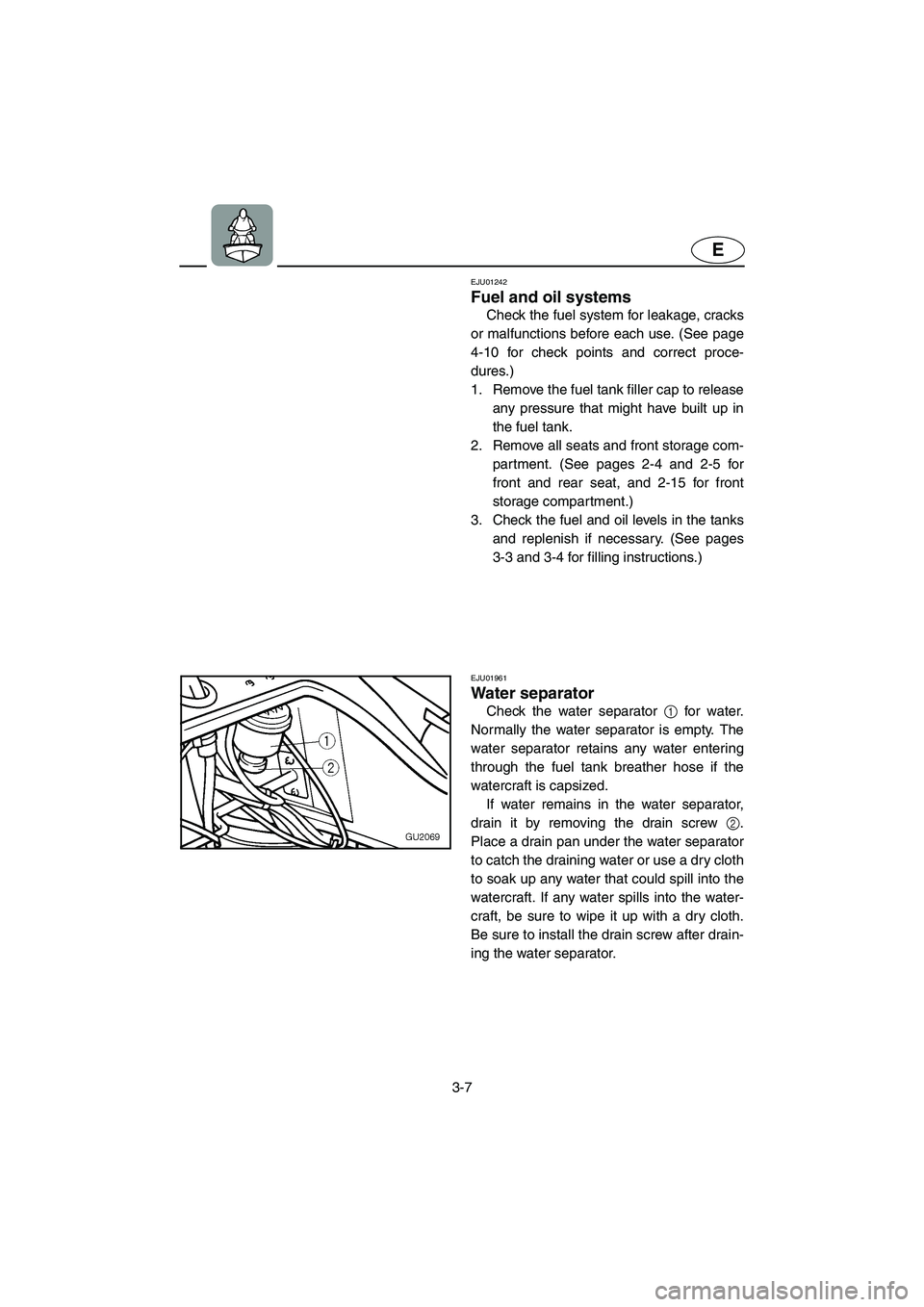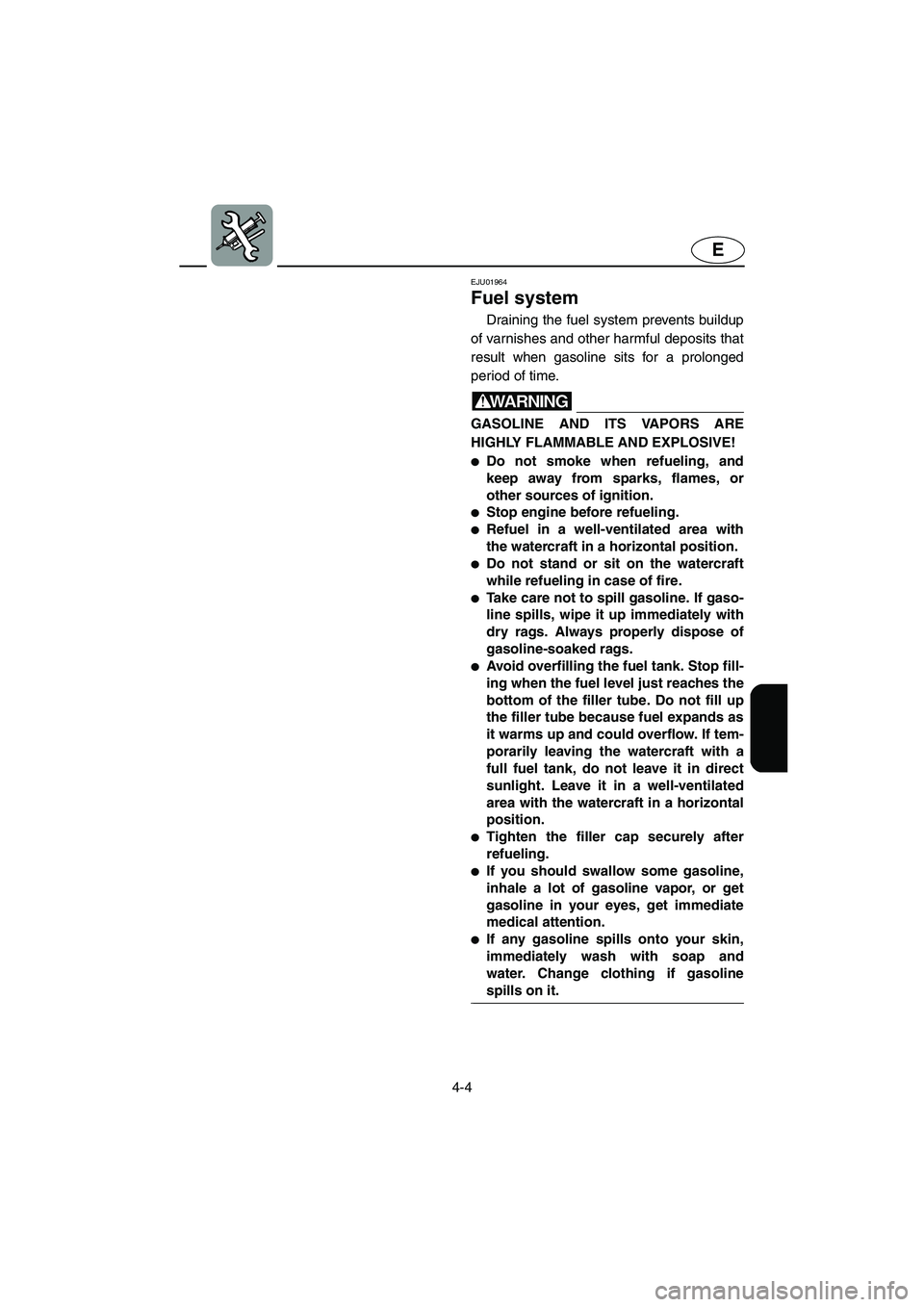Page 50 of 120

3-7
E
EJU01242
Fuel and oil systems
Check the fuel system for leakage, cracks
or malfunctions before each use. (See page
4-10 for check points and correct proce-
dures.)
1. Remove the fuel tank filler cap to release
any pressure that might have built up in
the fuel tank.
2. Remove all seats and front storage com-
partment. (See pages 2-4 and 2-5 for
front and rear seat, and 2-15 for front
storage compartment.)
3. Check the fuel and oil levels in the tanks
and replenish if necessary. (See pages
3-3 and 3-4 for filling instructions.)
EJU01961
Water separator
Check the water separator 1 for water.
Normally the water separator is empty. The
water separator retains any water entering
through the fuel tank breather hose if the
watercraft is capsized.
If water remains in the water separator,
drain it by removing the drain screw 2.
Place a drain pan under the water separator
to catch the draining water or use a dry cloth
to soak up any water that could spill into the
watercraft. If any water spills into the water-
craft, be sure to wipe it up with a dry cloth.
Be sure to install the drain screw after drain-
ing the water separator.
UF0M75.book Page 7 Thursday, May 29, 2003 9:53 AM
Page 60 of 120
3-17
E
2. Turn the fuel cock knob to the “ON” posi-
tion.
NOTE:@ Before starting the watercraft, after it has
been sitting, remove the fuel tank filler cap
to release any built-up pressure in the tank
due to fuel expansion.
@
3. Attach the clip 1 to the engine shut-off
switch 2. Also, attach the engine shut-
off cord 3 to your left wrist.
WARNING@ Check that the engine shut-off cord is not
frayed or broken, and keep it free from
the handlebars so the engine stops if the
operator falls off. The engine shut-off
cord may not pull free if wrapped around
the handlebars when the operator falls
off, allowing the watercraft to continue to
run and cause an accident.
@
NOTE:@ It is not possible to start the engine with the
clip removed from the engine shut-off
switch.
@
4. Pull and hold the choke knob all the way
out to start a cold engine.
NOTE:@ The choke should not be used when the
engine is warm.
@
UF0M75.book Page 17 Thursday, May 29, 2003 9:53 AM
Page 85 of 120

4-4
E
EJU01964
Fuel system
Draining the fuel system prevents buildup
of varnishes and other harmful deposits that
result when gasoline sits for a prolonged
period of time.
WARNING@ GASOLINE AND ITS VAPORS ARE
HIGHLY FLAMMABLE AND EXPLOSIVE!
�Do not smoke when refueling, and
keep away from sparks, flames, or
other sources of ignition.
�Stop engine before refueling.
�Refuel in a well-ventilated area with
the watercraft in a horizontal position.
�Do not stand or sit on the watercraft
while refueling in case of fire.
�Take care not to spill gasoline. If gaso-
line spills, wipe it up immediately with
dry rags. Always properly dispose of
gasoline-soaked rags.
�Avoid overfilling the fuel tank. Stop fill-
ing when the fuel level just reaches the
bottom of the filler tube. Do not fill up
the filler tube because fuel expands as
it warms up and could overflow. If tem-
porarily leaving the watercraft with a
full fuel tank, do not leave it in direct
sunlight. Leave it in a well-ventilated
area with the watercraft in a horizontal
position.
�Tighten the filler cap securely after
refueling.
�If you should swallow some gasoline,
inhale a lot of gasoline vapor, or get
gasoline in your eyes, get immediate
medical attention.
�If any gasoline spills onto your skin,
immediately wash with soap and
water. Change clothing if gasoline
spills on it.
@
UF0M75.book Page 4 Thursday, May 29, 2003 9:53 AM
Page 91 of 120
4-10
E
EJU01383
Inspecting the fuel system
WARNING@ Gasoline is highly flammable and explo-
sive. A fire or explosion can cause
severe injury or death. Shut off the
engine. Do not smoke. Avoid spilling
gasoline.
@
Check the fuel system for leaks, cracks,
or malfunctions. If any problem is found, do
the necessary repair or replacement as
required. If repair is necessary, consult a
Yamaha dealer.
Check:
�Carburetor for leakage.
�Fuel pump for malfunction or leakage.
�Fuel tank for water or dirt.
�Fuel tank for damage, cracks or leakage.
�Fuel hose joint for leakage.
�Fuel hose for cracks or other damage.
�Fuel filter for leakage.
�Fuel cock for leakage.
�Air vent check valve for leakage.
�Fuel tank filler cap for damage.
WARNING@ Failure to check for and repair any fuel
leakage may result in fire or explosion.
@
UF0M75.book Page 10 Thursday, May 29, 2003 9:53 AM
Page 103 of 120

4-22
E
EJU01359
Specifications
MODEL
ITEMUnit XL700
WATERCRAFT CAPACITY
Maximum people on board Number of people 3
Maximum load capacity kg (lb) 240 (530)
DIMENSIONS
Length mm (in) 3,150 (124)
Width mm (in) 1,250 (49)
Height mm (in) 1,100 (43)
Dry weight kg (lb) 245 (540)
PERFORMANCE
Maximum output kW (PS) @ r/min 58.8 (80)@6,250
Maximum fuel consumption L/h (US gal/h, Imp gal/h) 34.0 (9.0, 7.5)
Cruising range at full throttle hr. 1.5
Trolling speed r/min 1,250–1,350
ENGINE
Engine type 2-stroke
Number of cylinders 2
Engine displacement cm
3 (cu in) 701 (42.78)
Bore & stroke mm (in) 81.0 ×
68.0 (3.19 ×
2.68)
Compression ratio 7.2:1
Lubrication system Oil injection
Cooling system Water-cooled
Starting system Electric starter
Ignition system C.D.I.
Spark plug BR8HS (NGK)
Spark plug gap mm (in) 0.6–0.7 (0.024–0.028)
Battery capacity V-AH 12-19
Charging system Flywheel magneto
DRIVE UNIT
Propulsion system Jet pump
Jet pump type Axial flow, single stage
Impeller rotation Counterclockwise (Viewed from rear)
Transmission Direct drive from engine
Jet thrust nozzle angle Degree 24 + 24
FUEL AND OIL
Recommended fuel Regular unleaded gasoline
Minimum octane rating PON
RON86
90
Recommended engine oil YAMALUBE 2-W, or an equivalent NMMA-
certified TC-W3 marine oil
Fuel tank capacity
Total L (US gal, Imp gal) 50 (13.2,11)
Reserve L (US gal, Imp gal) 12 (3.2, 2.6)
Oil tank capacity L (US gal, Imp gal) 3.8 (1.0, 0.8)
UF0M75.book Page 22 Thursday, May 29, 2003 9:53 AM
Page 106 of 120

5-1
E
EJU01116
Troubleshooting
If you have any trouble with your watercraft, use this section to check for the possible
cause.
If you cannot find the cause, or if the procedure for replacement or repair is not described
in this Owner’s/Operator’s Manual, have a Yamaha dealer perform the necessary service.
EJU01367
Troubleshooting chart
TBC-F0P7ETROUBLE POSSIBLE CAUSE REMEDY PAGE
Engine does not
startStarter motor does not turn over
Engine shut-
off switchClip not in place Install clip
2-9
Fuse Burned out Replace the fuse and
check wiring4-21
Battery Run down Recharge 4-18
Poor terminal connec-
tionsTighten as required
4-18
Terminal corroded Clean 4-5
Starter motor Faulty Have serviced by
Yamaha dealer—
Starter motor turns over
Fuel cock Turned to “OFF”Turn the fuel cock to
“ON”2-8
Fuel Empty Refill as soon as
possible3-3
Stale or contaminated Have serviced by
Yamaha dealer4-10
Fuel tank Water or dirt present Have serviced by
Yamaha dealer4-11
Spark plug Fouled or defective Clean or replace 4-14
Spark plug cap Not connected or loose Connect properly 4-14
Crankcase Filled with water Crank engine with plug
out until clean5-8
Fuel filter Clogged or water
pooledHave serviced by
Yamaha dealer4-11
Choke Knob moves back on
its ownTighten the choke knob
adjusting nut4-17
UF0M75.book Page 1 Thursday, May 29, 2003 9:53 AM
Page 107 of 120
5-2
E
Engine runs irregu-
larly or stallsFuel Empty Refill as soon as
possible3-3
Stale or contaminated Have serviced by
Yamaha dealer4-10
Choke Knob pulled Push fully in 2-9
Fuel filter Clogged or water
pooledHave serviced by
Yamaha dealer4-11
Fuel tank Water or dirt present Have serviced by
Yamaha dealer4-11
Spark plug Fouled or defective Replace 4-14
Incorrect heat range Replace 4-14
Gap incorrect Adjust 4-14
Spark plug cap Loose Connect properly 4-14
Cracked, torn, or dam-
agedReplace
—
Electrical
wiringLoose connection Tighten or connect
properly—
Carburetor Incorrect idle adjust-
mentAdjust idle
4-20
Clogged Have serviced by
Yamaha dealer—
Warning light blinksEngine oil level Empty Refill immediately 3-4
Oil filter clogged Clean 4-12 TROUBLE POSSIBLE CAUSE REMEDY PAGE
UF0M75.book Page 2 Thursday, May 29, 2003 9:53 AM
Page 108 of 120
5-3
E
Wate rcr af t slow or
loses powerCavitation Jet intake clogged Clean 5-4
Impeller damaged or
wornHave serviced by
Yamaha dealer—
Engine over-
heatedJet intake clogged Clean
5-4
Fuel filter Clogged Have serviced by
Yamaha dealer4-11
Spark plug Fouled or defective Replace 4-14
Incorrect heat range Replace 4-14
Gap incorrect Adjust 4-14
Spark plug
capsLoose Connect properly
4-14
Electrical
wiringLoose connection Tighten or connect
properly—
Fuel Stale or contaminated Have serviced by
Yamaha dealer4-10
Bilge Water in bilge Drain 3-8 TROUBLE POSSIBLE CAUSE REMEDY PAGE
UF0M75.book Page 3 Thursday, May 29, 2003 9:53 AM